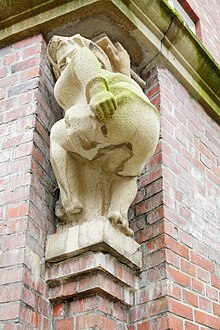Hans Hummel (city original)
Hans Hummel , real name Johann Wilhelm Bentz , (born January 21, 1787 in Hamburg ; † March 15, 1854 ) was a water carrier in Hamburg's Neustadt district and is considered the creator of the Hamburg greeting "Hummel, Hummel - Mors, Mors" . He is therefore still regarded today as the best-known representative of old Hamburg originals .
Life
According to tradition, Bentz, a disgruntled person, was teased by children by calling him by the mocking name "Hummel, Hummel", to which he replied with "Mors, Mors", a short form of the Low German expression "Klei mi an'n Mors" ( "Lick (t) my ass").
In combination with "Hans" - the short form of his first name "Johann (es)" - he became known under his nickname Hans Hummel . There are several explanations for the origin of the mock name Hummel :
- The mock name is traced back to the city soldier Daniel Christian Hummel from the French era, who was very popular with street children in Hamburg's Neustadt district because of his war stories. After his death, Bentz moved into his apartment, whereupon the nickname of his apartment predecessor changed to Bentz as a nickname.
- On the other hand, it is suspected that the name is derived from the North German term “Griephummer” or “Hummer” for short, the nickname of the also “attacking” bailiff ; "Hummer" was then linguistically ground to "Hummel".
When the Stadtwasserkunst in Hamburg-Rothenburgsort started operating in 1848 , Bentz became unemployed. He died in 1854 and was buried at the Dammtorfriedhof at the expense of the poor house .
Monuments
Representations of Hans Hummel, usually wearing a dark traditional costume and top hat and carrying the yoke with two buckets of water on his shoulder, can be rediscovered in various places in Hamburg. For example, the Hamburg waterworks show him on their car.
On a square on Rademachergang in Neustadt, which was built on with new apartment blocks as part of the demolition of the Gängeviertel from 1933 to 1937, the Association of Born-Born Hamburgers erected a fountain monument of the water carrier, created by the sculptor Richard Kuöhl , with the following inscription in 1938 :
"WITH DENN BOO-VEREEN TO HAMBORG TOHOOP OEVERGEVEN FROM DENN VEREEN GEB. HAMBORGER RV FROM 1897 TO DE HANSESTADT HAMBORG SUENNDAG SEPT. 13. 1938
(in high German, 'Together with the Bauverein zu Hamburg, handed over by the association born Hamburger RV from 1897 to the Hanseatic City of Hamburg on Sunday, September 13th 1938') "
Hummel is standing there by a pillar behind which children calling to him hide. Another children's sculpture can be found at the Memel House (corner of Rademachergang / Breiter Gang) of the General German Ship Carpenters Cooperative . There a boy stretches his backside towards the well.
An older well - Hummel standing on a column as a water dispenser - was built on the premises of the hospital in Barmbek .
A Hummel monument can also be found in the town of Bad Lauterberg in the Harz region: the so-called Hummel House is located in Hauptstrasse 79. On its facade there is a sculpture with the figure of the Hamburg water carrier.
Sculpture parade
As an action originally limited to October 2004, over one hundred figures of the water carrier made of fiberglass-reinforced plastic were erected in downtown Hamburg in 2003 . This copied an idea that was first implemented in 1998 in the cow culture in Zurich , then with the Buddy Bears in Berlin and later in the so-called animal parades in other cities.
The individual figures were individually painted by artists such as Jette Joop , mainly sponsored by retailers . Due to the great popularity of the Hamburg population and tourists, the action lasted longer than originally planned. On June 23, 2006, the figures were auctioned for the benefit of “A Roof for the Homeless” and raised 343,000 euros. You are now privately owned; some are still open to the public, e.g. B. in front of a senior citizens' residence in Hamburg-Rahlstedt, the building cooperative in Bargteheider Strasse or the Panoptikum.
literature
- Joachim W. Franck: Hummel . In: Franklin Kopitzsch, Dirk Brietzke (Hrsg.): Hamburgische Biographie . tape 3 . Wallstein, Göttingen 2006, ISBN 3-8353-0081-4 , p. 175-176 .
- Emilie Weber: memories of the youth 1836 to 1851 . Otto Meißner , Hamburg 1904
- Paul Möhring : Hummel. Hamburg's world-famous original . Hermes, Hamburg 1946 (Low German Library, vol. 190)
- Paul Möhring: Three Hamburg originals: Hummel - Zitronenjette - Vetter Kirchhoff. Hansa-Verlag, Husum 1987 ISBN 3-920421-52-3
Web links
Individual evidence
- ↑ Hamburg-Lexikon des Hamburger Abendblatt 2002; Kramer, Klaus: The private house bathroom 1850–1950 and the development of the sanitary trade, Schiltach: Hans Grohe, 1997, excerpt (PDF; 3 MB); , more precisely the content of a relevant tour by the renowned Hamburg provider.
- ↑ Note: According to Johann Friedrich Schütze (in Holsteinisches Idiotikon. A contribution to the history of folk customs , Hamburg 1800, p. 69), Griephummer is a Hamburg term for begging bailiffs who had to grab street beggars , derived from the sharp claws of a lobster.
- ^ Frank Kürschner-Pelkmann: Das Wasser-Buch, Verlag Otto Lembeck, 2007, ISBN 978-3-87476-531-2 [1] page 445
- ^ Wieland Höhne: Hamburg, Baedeker, 2007, ISBN 978-3-8297-1033-6 [2] page 50
| personal data | |
|---|---|
| SURNAME | Hummel, Hans |
| ALTERNATIVE NAMES | Bentz, Johann Wilhelm (real name); Bumblebee bumblebee (nickname) |
| BRIEF DESCRIPTION | Hamburg original |
| DATE OF BIRTH | January 21, 1787 |
| PLACE OF BIRTH | Hamburg |
| DATE OF DEATH | March 15, 1854 |
| Place of death | Hamburg |



